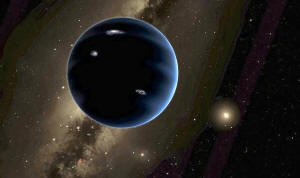|
 Researchers
find possible ninth planet beyond Neptune Researchers
find possible ninth planet beyond Neptune
 Send a link to a friend
Send a link to a friend
[January 21, 2016]
By Irene Klotz
CAPE CANAVERAL, Fla. (Reuters) - The solar
system may host a ninth planet that is about 10 times bigger than Earth
and orbiting far beyond Neptune, according to research published on
Wednesday.
|
|
 Computer simulations show that the mystery planet, if it exists,
would orbit more than 50 times farther from the sun than Earth,
astronomers with the California Institute of Technology in Pasadena
said. Computer simulations show that the mystery planet, if it exists,
would orbit more than 50 times farther from the sun than Earth,
astronomers with the California Institute of Technology in Pasadena
said.
So far, the planet has not been observed directly.
"It's a pretty substantial chunk of our solar system that's still
out there to be found, which is pretty exciting,” said astronomer
Mike Brown, whose discovery was published in this week’s
Astronomical Journal.
Brown and astronomer Konstantin Batygin, also at Caltech, initially
were skeptical that such a large planet would have eluded detection.
 But they modeled the hypothetical planet’s gravitational effects on
several known bodies in the region and found a near-perfect match.
The computer model also predicted the location of other objects
beyond Neptune, in a region known as the Kuiper Belt, and those were
found in archived surveys as well.
At that point, "my jaw sort of hit the floor," Brown said in a
statement.
Brown's earlier research helped to demote Pluto in 2006 as the solar
system’s ninth planet after other small, icy bodies were found
beyond Neptune.
[to top of second column] |

“All those people who are mad that Pluto is no longer a planet can
be thrilled to know that there is a real planet out there still to
be found," Brown said.
(This version of the story corrects in paragraph 2, orbit distance
to 50 times farther from the sun, not 20 times)
(Reporting by Irene Klotz; editing by Bill Trott, Letitia Stein and
Dan Grebler)
[© 2016 Thomson Reuters. All rights
reserved.]
Copyright 2016 Reuters. All rights reserved. This material may not be published,
broadcast, rewritten or redistributed.
 |